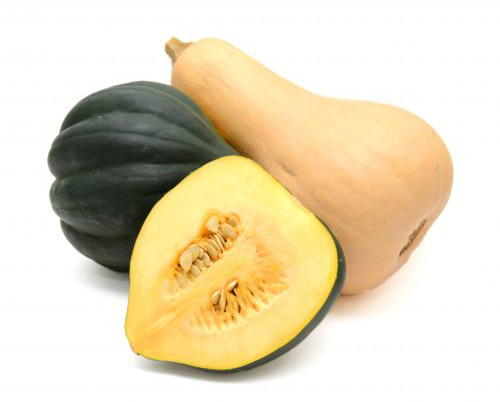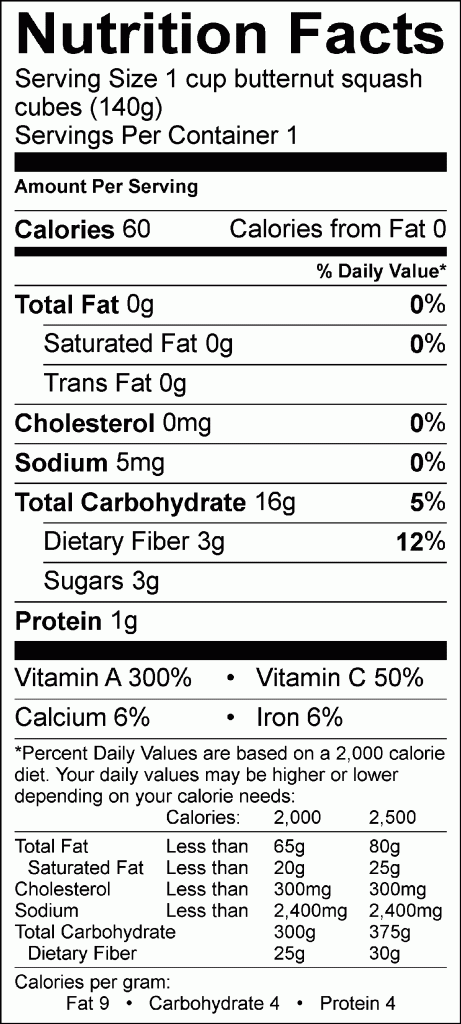Acorn Squash
First up, you may have guessed it, is acorn squash. Acorn squash is on the smaller side of winter squashes and has dark green skin with an orange, fleshy inside. The taste is sweet and can be doctored up in many different ways to enhance the flavor one way or another.
Banana Squash
Next up we have banana squash. Banana squash is big and elongated, with the ability to grow and weigh close to 40 pounds! The outside skin is usually a smooth orange color with bright orange flesh inside. This is a squash known for being quite rich, but perfect with the right palatable combination.
Butternut Squash
Butternut squash is often pear-shaped with a smooth outside skin that is a warm cream color with the same bright orange fleshy insides. Butternut squash is quite common as it is indeed considered the sweetest variety out of all classified hard squashes!
Buttercup Squash
The sweet and creamy flavor of buttercup squash is unexpected due to its heavy, round and dense outside skin. You may recognize this squash as it has a small green rind at the top.
Delicata Squash
This small squash has a creamy-yellow outer skin, typically with green stripes. It is also referred to as “sweet potato squash.” Indeed, the taste of this beauty is very similar to that of creamy sweet potatoes.
Hubbard Squash
This may be a new one to some of you! We’ve come to one of the largest varieties out of all hard squashes. The hard outer skin can be found anywhere from dark green to a grayish blue color. Fun fact: Hubbard Squash tastes just like a pumpkin!
Kabocha Squash
Round with a broad base, Kabocha squash is referred to as dull with dark green skin, often with small bumps, while the inside boasts a bright yellow flesh. It is considered very sweet combined with a robust nutty flavor, which makes for a perfect combination winter delicacy.
Pumpkin
The pumpkins that are everywhere out and about during the Fall months are often for decoration, while pumpkins that are meant for cooking are much smaller. These “sugar” pumpkins look the same as the large pumpkins, but they deliver potent flavors whereas field pumpkins are typically drier and therefore used most often for carving and decorating.
Spaghetti Squash
We bet you’re familiar with this variety because spaghetti squash is all the rage ever since gluten decided to go out style. More than ever, people are using this surprisingly mild squash to replace typical pasta noodles. You can easily cook spaghetti squash and fork it into short, noodle shapes and top with a Spaghetti sauce of your choice and hardly tell the difference. This is considered a great alternative to noodles because it is not sweet, which makes it perfect for more savory meals. This squash is cylindrical with a pale to yellow outer skin, and the inside is that is a vibrant orange color most winter squashes embody.
Sweet Dumpling Squash
Surprisingly, there’s no sweet dumpling flavor about it! This simple squash actually tastes very similar to corn! It has a small, orange/dark green exterior. If you’ve never tried a sweet dumpling, you definitely should at least once to experience this unique flavor.
Turban Squash
Living up to its name, Turban squash is large and in charge with what is referred to as an irregular turban shape with an orange/yellow bumpy outer skin. For as large as this squash is, it boasts mild and nutty flavors.




